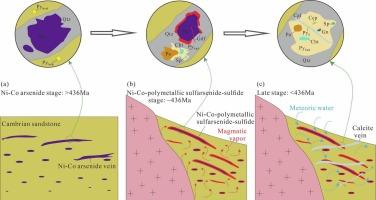大瑶山龙华镍钴热液脉状矿床镍钴多金属硫化物矿化的形成:来自原位磷灰石U-Pb年代学、硫化物S-Pb同位素和微量元素组成的制约
IF 3.6
2区 地球科学
Q1 GEOLOGY
引用次数: 0
摘要
龙华镍钴矿床位于华南大瑶山地区,具有主要赋存于石英脉中的镍钴砷化和镍钴多金属硫化物硫化物成矿特征。虽然以前的研究主要集中在镍钴砷化矿化的起源上,但对镍钴多金属硫化物硫化物矿化的了解仍然很少。显微观察和扫描电镜(SEM)显示,镍钴多金属硫化物-硫化物成矿阶段晚于早期的镍钴砷化成矿阶段。对后期与镍钴硫化物和镍钴多金属硫化物共存的磷灰石进行原位U-Pb测年,截距年龄较低,为436.2±6.9 Ma,与大瑶山地区加里东期花岗岩同期形成。闪锌矿地温计显示结晶温度在379 ~ 388℃之间,为中高温成矿流体。该阶段硫化物的原位S-Pb同位素分析显示,黄铁矿的δ34S值为- 0.5‰~ + 6.5‰(平均+ 1.4‰),闪锌矿的δ34S值为2.7‰~ 3.0‰(平均2.9‰),黄铁矿的Pb同位素比值与该区加里东期花岗岩相似,以岩浆源为主。这些新发现与前人的研究结果相结合,表明镍钴砷化和镍钴多金属硫化物成矿是一个多阶段演化过程,岩浆热液在镍钴多金属硫化物成矿阶段起着至关重要的作用。镍钴多金属硫化物硫化物矿化是在早期镍钴砷化矿化基础上的后续套印过程。该研究对热液型镍钴脉状矿床镍钴富集机理有新的认识,对今后大瑶山地区找矿具有重要指导意义。本文章由计算机程序翻译,如有差异,请以英文原文为准。

Formation of Ni-Co-polymetallic sulfarsenide-sulfide mineralization in the Longhua Ni-Co hydrothermal vein deposit, Dayaoshan area, South China: Constraints from in-situ apatite U-Pb geochronology, sulfide S-Pb isotopes and trace element compositions
The Longhua Ni-Co deposit, situated in the Dayaoshan area of South China, is characterized by Ni-Co arsenide and Ni-Co-polymetallic sulfarsenide-sulfide mineralization primarily hosted within quartz veins. While previous studies have focused on the origin for the Ni-Co arsenide mineralization, the Ni-Co-polymetallic sulfarsenide-sulfide mineralization remains less understood. In this study, microscopic observation and scanning electron microscopy (SEM) revealed the Ni-Co-polymetallic sulfarsenide-sulfide mineralization stage that postdates the earlier Ni-Co arsenide mineralization stage. In-situ U-Pb dating of apatite coexisting with Ni-Co sulfarsenide and Ni-Co-polymetallic sulfide from this later stage yielded an lower intercept age of 436.2 ± 6.9 Ma, contemporaneous with the Caledonian granites in the Dayaoshan area. Sphalerite geothermometer indicate a crystallization temperature ranging from 379 °C to 388 °C, suggesting a moderate-high temperature ore-forming fluid. In-situ S-Pb isotope analysis of sulfide from this stage revealed δ34S values of −0.5 ‰ to + 6.5 ‰ (mean + 1.4 ‰) for pyrite and 2.7 ‰ to 3.0 ‰ (mean 2.9 ‰) for sphalerite, with pyrite showing similar Pb isotopic ratios to those for Caledonian granites in the region, indicating a predominantly magmatic source characteristic. These new findings, combined with evidences from previous studies, suggest a multi-stage evolutionary process for Ni-Co arsenide and Ni-Co-polymetallic sulfarsenide-sulfide mineralization, with magmatic hydrothermal fluids playing a crucial role during the Ni-Co-polymetallic sulfarsenide-sulfide mineralization stage. The Ni-Co-polymetallic sulfarsenide-sulfide mineralization represents a subsequent overprinting process superimposed on the earlier Ni-Co arsenide mineralization. This study provides new insights into the Ni-Co enrichment mechanism in hydrothermal Ni-Co vein deposits and offers valuable guidance for future prospecting in the Dayaoshan area.
求助全文
通过发布文献求助,成功后即可免费获取论文全文。
去求助
来源期刊

Ore Geology Reviews
地学-地质学
CiteScore
6.50
自引率
27.30%
发文量
546
审稿时长
22.9 weeks
期刊介绍:
Ore Geology Reviews aims to familiarize all earth scientists with recent advances in a number of interconnected disciplines related to the study of, and search for, ore deposits. The reviews range from brief to longer contributions, but the journal preferentially publishes manuscripts that fill the niche between the commonly shorter journal articles and the comprehensive book coverages, and thus has a special appeal to many authors and readers.
 求助内容:
求助内容: 应助结果提醒方式:
应助结果提醒方式:


